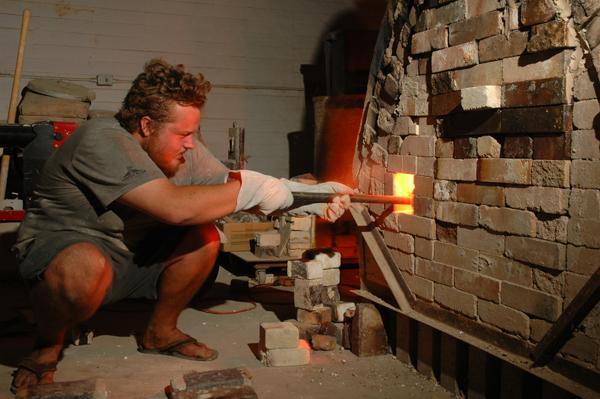Kilns distinguish the ceramics department

kilns:Paulius Rekasius, senior studio art major, worked past midnight at school on Sept. 15, in order for the ovens to be just the right temperature to salt the ceramics kiln. The oven can get to temperatures as high as 2,200-2,300 degrees Fahrenheit.:Ryan Greenleaf
September 30, 2009
The availability of ceramic kilns at Sacramento State distinguishes this school’s ceramics program from other universities in California.
Megan Mitchell and Jessica Thompson both went to Sac State to gain work experience and improve their portfolios. Mitchell is now a Master of Fine Arts student at Utah State University and Thompson is at the New York State College of Ceramics at Alfred University, a premier graduate school for ceramics.
“I’m definitely proud of the fact that in the last three years, we’ve had students go to really good schools, and all of them are getting scholarships,” said Scott Parady, professor of ceramics. “And there are more students who are on their way to that path.”
Mitchell said her coursework at Sac State allowed her to be accepted to Utah State, which accepts fewer students each year.
The department, through grant funding, had built two kilns, a salt kiln and a wood kiln.
In 2005, the California State University Sacramento Foundation awarded a $1,000 grant to Lori Lockamy, a Sac State student at that time.
Lockamy used the grant money to build the salt kiln as part of her independent study coursework.
Under Parady’s supervision, she and about six other students spent two months building the kiln.
In fall 2008, the art department awarded Parady a $10,000 grant, which he used to build the wood kiln. In spring 2009, the kiln was built as a project in two of Parady’s advanced classes and took about three months to finish.
“We’re sort of the only university in California that has a wood kiln that works well,” Parady said. “It’s something that distinguishes our program.”
The department currently has two ceramics professors, Parady and Robert Brady. Brady will retire next semester.
“We haven’t been able to hire anybody for several years because of the budget,” Parady said. “I’m really hopeful for being able to hire at least one after he’s gone because it’s going to be really difficult to just have one professor.”
With the budget cuts, having kilns in the department is beneficial, Parady said.
“The wood kiln actually saves money for the university because we collect all the woods, and we’re working with the Grounds (and Landscape Services) to recycle,” he said.
Ceramic kilns are used to fire clay materials that have been shaped and dried. The final products are pots, porcelains and sculptures with earthy colors.
Parady said working with both kilns take an immense amount of work. The wood kiln fires for about two days and the salt kiln for a day.
“The one thing about it that is kind of unique is that it’s smokeless, so it’s actually very green-friendly,” Parady said.
Sac State students have not been given the opportunity to learn how to build and fire kilns since the mid-1980s.
“Back then, they never had a wood kiln and salt kiln,” said Trent Burkett, who got his Bachelor of Arts and Master of Arts degrees, both concentrated in ceramics, at Sac State in 1993 and 1998, respectively.
Over the years, the department has produced graduates who have gone on to teaching careers.
Burkett has been a ceramics professor at the University of the Pacific for 10 years.
“Robert Brady and (former ceramics professor) Peter Vandenberg were really key people for me that really supported and helped me get better,” he said.
Linda Gelfman, ceramics instructor at American River College, got her master’s degree in 1993.
“Sac State gave me a good place to work for four years,” Gelfman said. “It was inexpensive at that time, and I had great peers. I got a good education not necessarily from the teachers, but because of the students.”
Gelfman taught at Sac State in 1999 and has been a ceramics instructor at ARC since 2001.
“I think the ceramics program has a lot to offer in terms of facilities and faculty,” Mitchell said. “Students have an opportunity to work in the studios any hour of the day and use the equipment.”
Kristine Guerra can be reached at kguerra@statehornet.com.































































































































